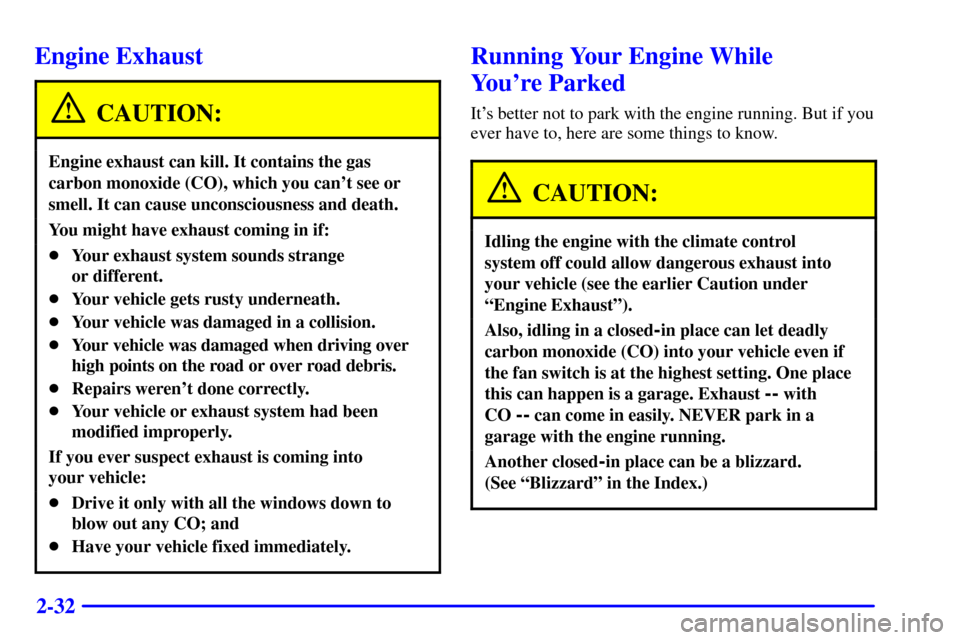Page 70 of 359

2-10 Resynchronization
Pressing the transmitter buttons numerous times
(approximately 250 times) out of the vehicle's operating
range may cause the transmitter not to work. Replacing
the battery and pressing the transmitter buttons out
of range will also cause the transmitter not to work.
If only the fuel door button works, the transmitter needs
to be resynchronized to the receiver. Do this by pressing
and holding both the lock and unlock buttons on the
transmitter for about eight seconds. You must be within
range of the vehicle.
Once the transmitter has been resynchronized, the horn
will sound and the exterior lamps will flash once. The
system should now operate properly. See your dealer for
service if your transmitter still doesn't work properly.
Trunk
CAUTION:
It can be dangerous to drive with the trunk lid
open because carbon monoxide (CO) gas can
come into your vehicle. You can't see or smell
CO. It can cause unconsciousness and even death.
If you must drive with the trunk lid open or if
electrical wiring or other cable connections must
pass through the seal between the body and the
trunk lid:
�Make sure all other windows are shut.
�Turn the fan on your heating or cooling
system to its highest speed with the setting
on AUTO and the temperature between
65�F (18�C) and 85�F (29�C). That will
force outside air into your vehicle.
See ªComfort Controlsº in the Index.
�If you have air outlets on or under the
instrument panel, open them all the way.
See ªEngine Exhaustº in the Index.
Page 72 of 359

2-12 Trunk Lid Tie Down (If Equipped)
CAUTION:
Driving with the trunk lid open can allow
dangerous CO (carbon monoxide) gas to come
into your vehicle. You can't see or smell CO.
It can cause unconsciousness and even death.
If you ever need to drive with your trunk lid
open, then:
�Make sure all windows, the rear seat
pass
-through and sunroof are closed.
�Turn the fan on your heating and cooling
system to its highest speed, with the setting
on VENT. This forces fresh outside air into
your vehicle.
�Open all air ducts on the instrument panel.
Don't use the trunk lid tie down if you are towing
a trailer because of the danger of CO.
This feature is used to secure the trunk lid if it will not
close completely, such as when carrying large packages
in the trunk.
1. Attach the end loop of the tie down to the retainer
located at the center of the trunk sill (see view B).
2. Attach the clip end of the tie down to the D
-ring on
the trunk lid (see view A).
3. Tighten the tie down by pulling the free end of the
cord until secure.
4. To remove the tie down, press the clip end to release
and loosen the cord.
Page 73 of 359

2-13
Theft
Vehicle theft is big business, especially in some cities.
Although your vehicle has a number of theft
-deterrent
features, we know that nothing we put on it can make
it impossible to steal. However, there are ways you
can help.
Key in the Ignition
If you leave your vehicle with the keys inside, it's an
easy target for joy riders or professional thieves
-- so
don't do it.
When you park your vehicle and open the driver's door,
you'll hear a chime reminding you to remove your key
from the ignition and take it with you. Always do this.
Your steering wheel will be locked, and so will your
ignition and transaxle. And remember to lock the doors.
Parking at Night
Park in a lighted spot, close all windows and lock your
vehicle. Remember to keep your valuables out of sight.
Put them in a storage area, or take them with you.
Parking Lots
If you park in a lot where someone will be watching
your vehicle, it's best to lock it up and take your keys.
But what if you have to leave your ignition key?
�If possible, park in a busy, well lit area.
�Put your valuables in a storage area, like your
trunk or glove box. Be sure to close and lock the
storage area.
�Close all windows.
�Move the trunk release lockout switch to ON.
�Lock the glove box.
�Lock all the doors except the driver's.
�Then take the door key and remote keyless entry
transmitter with you.
�Lock all doors except the driver's.
�Give the valet key to the valet. Then take the master
key with you.
Page 75 of 359

2-15 Testing the Alarm
1. From inside the vehicle, roll down the window,
then get out of the vehicle, keeping the door open.
2. From outside of the vehicle, with the door open,
lock the vehicle using the power door lock or the
RKE system and close the door. Wait 30 seconds
until the SECURITY lamp goes off.
3. Reach in and unlock the door using the manual lock
and open the door. The horn will sound and the
hazard lights will flash.
You can turn off the alarm by unlocking the driver's
door with your key, using the unlock button on the
RKE transmitter or by starting the car with a valid key.
If the alarm does not sound when it should, check to
see if the horn works. The horn fuse may be blown.
To replace the fuse, see ªFuses and Circuit Breakersº
in the Index. If the fuse does not need to be replaced,
you may need to have your vehicle serviced.
To reduce the possibility of theft, always arm the
theft
-deterrent system when leaving your vehicle.
Valet Lock
This switch is located inside the glove box on the left
side. Pressing this switch to ON will disable the use of
the trunk, fuel door and garage door opener.
Pressing this switch to
OFF will enable these
features for use.
Locking the glove box with your key will also help to
secure your vehicle. Note that the RKE transmitter can't
open the trunk or fuel door if the valet lock switch is in
the ON position.
Page 79 of 359

2-19
ACC: This position lets you use things like the radio,
windshield wipers, power windows and sunroof (option)
when the engine is off. Use ACC if you must have your
vehicle in motion while the engine is off (for example,
if your vehicle is being pushed).
ON: This is the position for driving.
START: This position starts the engine.
Retained Accessory Power (RAP)
The following accessories on your vehicle may be used
for up to 10 minutes after the ignition key is turned from
ON to OFF:
�Cellular Phone (If Equipped)
�Radio
�Power Windows
�Audio Steering Wheel Controls
�Sunroof (Option)Power to these accessories stops after 10 minutes or
if any door is opened. If you want power for another
10 minutes, close all the doors and turn the ignition key
to ON and then back to OFF. If the cellular phone is
being used while Retained Accessory Power is in effect,
the timer is suspended (to avoid interruption of the call).
The timer resets to 10 minutes at the end of the call.
Starting Your Engine
Move your shift lever to PARK (P) or NEUTRAL (N).
Your engine won't start in any other position
-- that's
a safety feature. To restart when you're already moving,
use NEUTRAL (N) only.
NOTICE:
Don't try to shift to PARK (P) if your vehicle
is moving. If you do, you could damage the
transaxle. Shift to PARK (P) only when your
vehicle is stopped.
Page 90 of 359

2-30 Ultrasonic Rear Parking Assist
(URPA)(Option)
Ultrasonic rear parking assist can help you to determine
how close an object is to your rear bumper within a
given area, making parking easier.
The URPA display is located inside the vehicle, above
the rear window. It has three color
-coded lights that can
be seen through the rearview mirror.
How the System Works
Ultrasonic rear parking assist comes on automatically
when the shift lever is moved into REVERSE (R) and
the vehicle speed is less than 3 mph (5 km/h). When the
system comes on, the three lights on the display will
illuminate to let you know that the system is working.
URPA senses how close your vehicle is to an object. The
distance is determined by the four rear sensors located
on the bumper. When shifting into REVERSE (R) and
an object is detected, one of the following will occur:
A chime will sound the first time an object is detected,
if the object is between 20 inches (0.5 m) and 5 feet
(1.5 m) away.
URPA can detect objects 3 inches (7.6 cm) and wider,
and at least 10 inches (2.5 cm) tall, but cannot detect
objects that are above trunk level. In order for the rear
sensors to recognize an object, it must be within
operating range.
Page 92 of 359

2-32
Engine Exhaust
CAUTION:
Engine exhaust can kill. It contains the gas
carbon monoxide (CO), which you can't see or
smell. It can cause unconsciousness and death.
You might have exhaust coming in if:
�Your exhaust system sounds strange
or different.
�Your vehicle gets rusty underneath.
�Your vehicle was damaged in a collision.
�Your vehicle was damaged when driving over
high points on the road or over road debris.
�Repairs weren't done correctly.
�Your vehicle or exhaust system had been
modified improperly.
If you ever suspect exhaust is coming into
your vehicle:
�Drive it only with all the windows down to
blow out any CO; and
�Have your vehicle fixed immediately.
Running Your Engine While
You're Parked
It's better not to park with the engine running. But if you
ever have to, here are some things to know.
CAUTION:
Idling the engine with the climate control
system off could allow dangerous exhaust into
your vehicle (see the earlier Caution under
ªEngine Exhaustº).
Also, idling in a closed-in place can let deadly
carbon monoxide (CO) into your vehicle even if
the fan switch is at the highest setting. One place
this can happen is a garage. Exhaust
-- with
CO
-- can come in easily. NEVER park in a
garage with the engine running.
Another closed-in place can be a blizzard.
(See ªBlizzardº in the Index.)
Page 93 of 359
2-33
CAUTION:
It can be dangerous to get out of your vehicle if
the shift lever is not fully in PARK (P) with the
parking brake firmly set. Your vehicle can roll.
Don't leave your vehicle when the engine is
running unless you have to. If you've left the
engine running, the vehicle can move suddenly.
You or others could be injured. To be sure your
vehicle won't move, even when you're on fairly
level ground, always set your parking brake after
you move the shift lever to PARK (P).
Follow the proper steps to be sure your vehicle won't
move. See ªShifting Into PARK (P)º in the Index.
If you are parking on a hill and if you're pulling a
trailer, also see ªTowing a Trailerº in the Index.
Windows
Power Windows
The power window controls are located on the armrest
near each window. Press the up or down arrows on the
controls to raise or lower the windows.
Your vehicle has Retained Accessory Power (RAP).
See ªRetained Accessory Powerº in the Index.